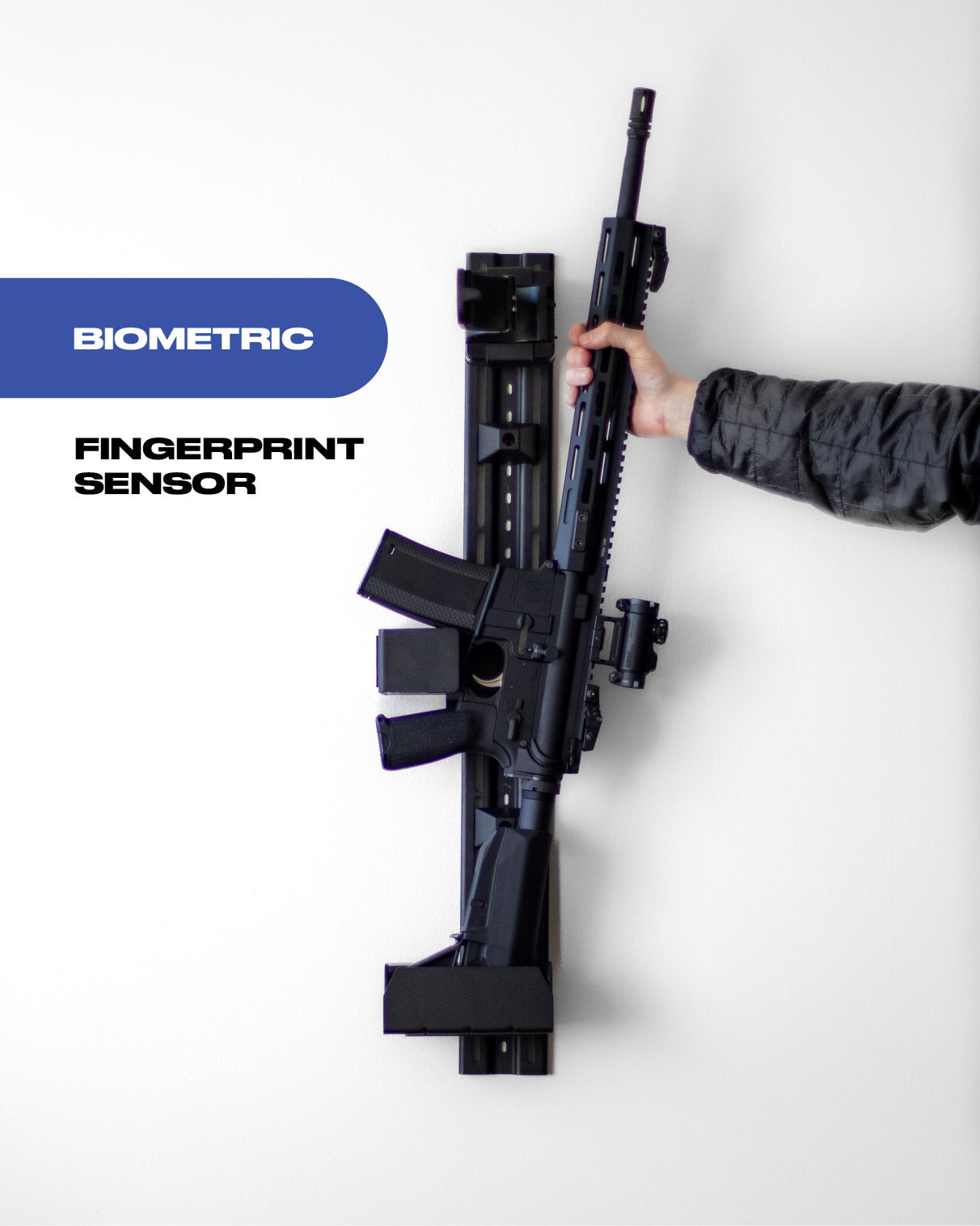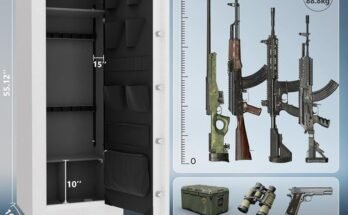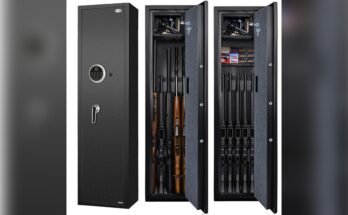You want your firearms to be safe, but also easy to access when it matters most. That’s where biometric rifle safes come in.
But are they truly reliable? Can you trust your gun’s security to a fingerprint scanner? You’ll discover the truth behind biometric safes—how they work, their strengths, and what risks you should be aware of. Keep reading to find out if this technology can give you peace of mind or if it’s better to look elsewhere for protecting your rifles.
Biometric Technology In Rifle Safes
Biometric technology makes rifle safes more secure and easy to use. It uses unique physical traits to allow access only to authorized users. This stops others from opening the safe without permission.
Rifle safes with biometric locks are faster to open than traditional key locks or combinations. This is important in urgent situations. The technology has improved over time and is now very reliable.
How Biometric Scanners Work
Biometric scanners read a specific part of your body. Most rifle safes use fingerprint scanners. The scanner captures your fingerprint and turns it into a digital code.
This code is compared to stored codes in the safe’s memory. If it matches, the safe unlocks quickly. If not, the safe stays locked. This process takes just seconds.
Each fingerprint is unique, which makes this method very secure. The scanner works by shining light and reading the pattern of ridges on your finger.
Types Of Biometric Sensors
There are mainly two types of biometric sensors in rifle safes: optical and capacitive. Optical sensors use light to create an image of your fingerprint.
Capacitive sensors use electrical signals to map the fingerprint. They are usually more accurate and harder to fool.
Some advanced safes use multi-sensor technology, combining both types. This increases the reliability and security of the safe.

Benefits Of Biometric Rifle Safes
Biometric rifle safes offer several advantages over traditional locking systems. They use fingerprint recognition for access, making them more reliable and user-friendly. These safes provide peace of mind by securing firearms effectively while allowing quick access when needed.
Quick Access During Emergencies
Biometric safes open fast by reading fingerprints. This helps in urgent situations where every second counts. No need to fumble with keys or remember codes. Just place your finger on the scanner, and the safe unlocks quickly. This speed can be vital for personal protection or emergency response.
Enhanced Security Features
These safes use advanced technology to prevent unauthorized access. Fingerprint scanners are difficult to trick or bypass. Many models lock automatically after a failed attempt. Some also include alarms that alert you if tampered with. This adds an extra layer of protection for your rifles.
Common Concerns And Limitations
Biometric rifle safes offer modern security but come with some common concerns. Understanding these limits helps in choosing the right safe. These safes rely on technology, which can sometimes fail or face challenges. Knowing these issues prepares users for smooth operation and safety.
False Rejections And Errors
Biometric sensors can reject authorized users. Dirt, moisture, or skin conditions may cause errors. Sometimes, the sensor does not read fingerprints correctly. This issue delays access during urgent moments. Regular cleaning and proper setup reduce false rejections. Users should register multiple fingerprints for backup. This helps avoid lockouts and frustration.
Power And Battery Dependence
Biometric safes need power to work. Most run on batteries that must be replaced often. Dead batteries can lock users out completely. Some models have backup keys for emergencies. Battery life varies by usage and quality. Checking and changing batteries regularly prevents problems. Using high-quality batteries extends safe operation time.

Comparing Biometric Safes To Traditional Safes
Biometric rifle safes and traditional safes both protect firearms, but they work in different ways. Each type offers unique benefits and challenges. Comparing these safes helps decide which fits your needs better. This section breaks down their differences by security and user convenience.
Security Level Differences
Traditional safes use keys or combination locks. They provide solid protection against theft. However, keys can be lost or stolen. Combinations can be guessed or forgotten.
Biometric safes use fingerprint scanners. They allow access only to registered users. This reduces the risk of unauthorized entry. The scanner may fail if fingers are wet or dirty. Some models include backup keys or codes.
Both safes are made with strong materials. Steel thickness and lock quality matter most. Biometric safes add an electronic layer. Traditional safes rely on mechanical locks.
User Convenience Factors
Traditional safes need manual unlocking. This can take extra time in urgent situations. Remembering combinations or carrying keys is necessary.
Biometric safes open quickly with a fingerprint scan. No need to remember codes or carry keys. This is useful during emergencies. Some users find fingerprint scanning easier and faster.
Biometric safes require batteries or power. Battery failure can cause access problems. Traditional safes do not depend on electricity.
Expert Opinions On Reliability
Experts provide useful insights on biometric rifle safes. Their views help us understand how reliable these safes truly are. This section shares opinions from security professionals and real users. Both groups highlight strengths and potential issues. These perspectives help readers make smart decisions about biometric safes.
Security Professionals’ Views
Security experts often praise the quick access biometric safes offer. They note that fingerprint scanners speed up opening times. Experts also mention strong build materials used in many models. These features increase safety against theft.
Some professionals warn about electronic failures. They advise having backup access methods like keys. Experts stress regular maintenance to ensure sensors work well. Overall, they see biometric safes as reliable when used correctly.
User Experience And Feedback
Many users report positive experiences with biometric rifle safes. They like how fast and easy it is to unlock. Users also appreciate the peace of mind these safes provide.
Some users face issues like sensor misreads or battery problems. They suggest testing the safe regularly to avoid surprises. Many recommend safes with multiple fingerprints saved. This adds flexibility and safety.
User feedback shows biometric safes work best with care and attention. When treated well, these safes offer dependable security for firearms.

Maintenance And Best Practices
Maintaining a biometric rifle safe is key to keeping it reliable and secure. Proper care helps prevent malfunctions and extends the safe’s life. Simple steps can ensure the biometric system works well every day.
Regular Testing And Updates
Test the safe’s fingerprint scanner regularly. This checks if the sensor reads prints correctly. Try different fingers to confirm consistent access. Update the safe’s software if the manufacturer provides new versions. Updates fix bugs and improve recognition accuracy. Replace batteries on time to avoid power failures. A well-powered safe responds faster and more reliably.
Proper Storage Conditions
Place the safe in a dry and cool spot. High humidity can damage electronic parts inside. Avoid direct sunlight, which heats the safe and harms sensors. Keep the safe away from dust and dirt. Clean the fingerprint scanner gently with a soft cloth. Proper storage reduces wear and keeps the safe functioning well.
Choosing The Right Biometric Rifle Safe
Choosing a biometric rifle safe takes careful thought. It must keep your firearms secure and ready. Safety, speed, and reliability matter most. Picking the right safe means knowing what features to seek. Not all biometric safes offer the same protection or ease of use.
Understanding trusted brands and popular models helps narrow your choices. Quality matters for long-term security and durability. This guide helps you find the best biometric safe for your rifles.
Key Features To Look For
Start with fast and accurate fingerprint recognition. The safe should open quickly with minimal delay. Look for a backup key or code option in case of failure. Solid steel construction resists tampering and break-ins. Fire protection adds extra security against heat damage. Interior padding prevents scratches on your firearms. Check the size to fit your rifles comfortably. Battery life must support frequent use without constant changes. Some safes include low battery alerts for convenience.
Trusted Brands And Models
Brands with strong reputations offer reliable biometric safes. GunVault, Vaultek, and Barska are popular choices. GunVault models often feature quick access and sturdy builds. Vaultek safes combine smart technology with solid protection. Barska provides a range of sizes and entry options. Reading user reviews reveals real-world performance and issues. Choose a model with consistent positive feedback. Warranty and customer service also matter for peace of mind.
Frequently Asked Questions
How Secure Are Biometric Rifle Safes?
Biometric rifle safes use fingerprint sensors for quick and secure access. They offer strong protection against unauthorized use. High-quality models include anti-tamper features and durable materials, enhancing overall security for your firearms.
Do Biometric Safes Work In Emergencies?
Yes, biometric safes provide fast access during emergencies. Fingerprint recognition takes only seconds, allowing quick retrieval of rifles. Many models also include backup keys or passcodes for additional access options.
Can Biometric Safes Prevent Unauthorized Gun Access?
Biometric safes significantly reduce unauthorized access risks. Only registered fingerprints can open the safe. This feature helps keep firearms away from children and intruders, promoting responsible gun ownership.
How Reliable Is Biometric Technology In Rifle Safes?
Biometric technology in rifle safes is highly reliable with modern sensors. They accurately read fingerprints even in low light or with minor finger injuries. Regular maintenance ensures consistent performance over time.
Conclusion
Biometric rifle safes offer quick access with secure protection. They use fingerprint scans to keep guns safe from others. Still, technology can sometimes fail or need maintenance. Choose a safe from a trusted brand for better reliability. Regularly test the scanner to ensure it works well.
These safes help balance safety and convenience. They suit gun owners who want fast entry and security. Think about your needs before buying one. Safe storage matters for every responsible gun owner.



